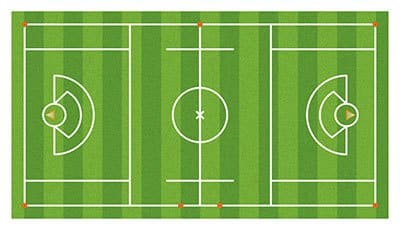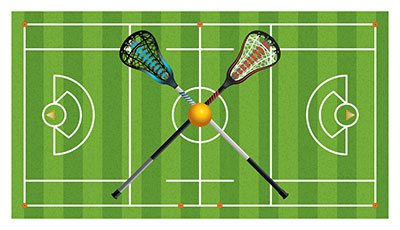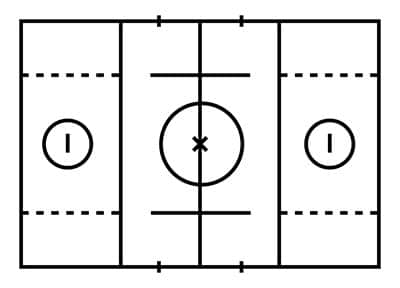Lacrosse players of all levels need to understand the rule changes in effect, especially those dealing with the goal line extended. Knowledge is vital when it comes to improving your game and ensuring you can compete on a level playing field.
With this guide, we break down what the goal line extended in lacrosse means, how it's implemented, and why it matters so you can take advantage of this new rule change.
Read on for more information about understanding and using goal line extended within your competitive bouts!
More...
Take Away Key Points:
All You Need to Know About the Goal Line Extended
If you're wondering what the purpose of this line is, read the guide below to find crucial information for the utmost performance and no mistakes.
What is the goal line extended?

The goal line extended or the GLE marks an imaginary line that is even with the goal line. The line extended runs parallel to the end line, extending out to the sidelines.
What is the purpose of the line extended?
The primary purpose of the line is to position a restart after a penalty call. Another purpose of the line is to provide a place to position a cutter or a feeder in a settled offensive play.
What is a settled offensive play?
A settled offensive play refers to the attackers on the lacrosse field having possession in their scoring half. The defensive half has time to set up a zone defense or man-to-man defense. In a settled point, the pace is slower than in a fast break. Various teams will often run set plays during the settled offense.
How to play around the extended line?
Since you push through the goal line extended, the defender tries to push you back toward the end line. You might use your force to beat him; however, it may not work, and you could even injure yourself.
The best offensive players use dodges at GLE to get away and also side-arm at the goal. With various defensive strategies, you might apply these effective moves to beat the defense and create scoring opportunities.
The two dodge types you can use for the GLE include: Z-dodge and S-dodge.
Z-dodge

The Z-dodge includes zigzag patterns and sharp angles. The technique is valuable when making an overaggressive defender off balance. The procedure is the following: the defender pushes you at the GLE, but you push him back for the separation.
Simultaneously, you will place your hands on the stick in a passing position to fake a pass. As the defender throws himself at you to stop the pass, you will perform a dodge. After the re-attack, you perform another dodge to skip past sliding defenders.
Finally, when you're open, you will transition to the shooting hand placement to create an opportunity for a shot.
S-dodge
S-dodge includes subtle fashion and more curves, unlike the Z-dodge. As you reach the top side of the line, you will go wide to the side not to draw additional lacrosse defenders. You can do a rollback behind the goal and switch hands if the defender pushes you back.
As you cross the topside and can now feed your teammates, you can cradle with two hands. At this point, the lacrosse defender recovers to get on your hands. However, you will dodge and change direction again with one hand. Once you deceive the defender, you can get in front of him and try to shoot the lacrosse ball.
You can try to dodge behind the goal, but there is a heck. You must cross the topside within five steps to each side of the pipe to become a threat. If not, you will be too far away to feed your teammate or try shooting the ball.
Defend at the goal line extended

Let's see how defensive players stop the offensive teams on the lacrosse field from shooting and winning the game of lacrosse. The crucial factor is to find the balance between when to push and when to pull to gain ball possession.
An offensive player starts running from the X position from one side of the lacrosse field to the extended line. You must be ready. You can bend your knee, engage your body and core to defend him from crossing the boundary, and square up.
The offense might push you topside as he accumulates good momentum in the sport. However, you must match him and stop him at the line extended. Once he has crossed the line, he might shoot the ball and score. Also, if you engage him too high, the player will easily get past you and dodge.
Once you reach the line that extends to the sideline, stay near the attacker and try to use the crease to push him away from the goal to the other side. The term is known as closing the gate, and your defending arc is similar to that of the closing door.
As the attacker tries to roll dodge, you can follow your feet and sling to change from an inside angle to an outside angle of the offender. So, throughout the process, you must stay low and drive the offender out. You can get him back to the X position without leaving too much space for a dodge.
Don't forget to use the crease as the end line when defending. You also have to use much strength, physicality, and agility for a successful ball interception and prevention of scoring.
Frequently Asked Questions
What are the lines for in lacrosse?
There are four lines on the lacrosse field to add structure and mark each boundary for each specific lacrosse player. These include:
1. End line - to determine who has possession of the ball
2. Sideline - sideline is a boundary line on the lacrosse field. It serves for substitutions and ball possession after a restart
3. Midfield line - the midfield line divides the lacrosse field into two halves - offensive and defensive, and the face-off also takes place there.
4. Restraining line - restraining line determines the attacking and defensive lacrosse areas, and these lines create a restraining box for penalties like offsides and similar penalties.
How far from the end line is the goal in lacrosse?
The goal in lacrosse is positioned fifteen yards away from the end line. Goals are centered between the sidelines.
How far is the restraining line from the goal?
The restraining line is positioned twenty yards away from the goal.
How wide are the lines on a lacrosse field?
All lines on the lacrosse field are 5.1 cm wide.
What is the center line of the lacrosse field called?
The center line of the lacrosse field is called the midfield line, which divides the field into equal zones.
Summary
The purpose of the goal line extended in lacrosse is to give the attacking team more space to score. It also allows for easier calling of shots and saves by the officials.
The other lines on the lacrosse field are equally important and include the midfield, restraining, sideline, and end lines.
When all these lines are considered together, they provide a clear surface helping keep the game fair and exciting for everyone involved.
